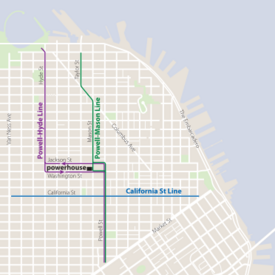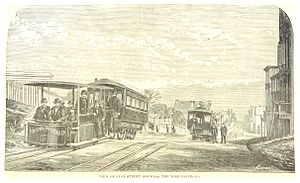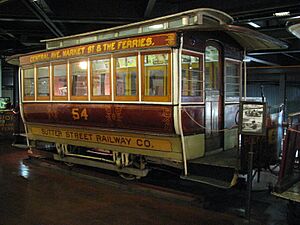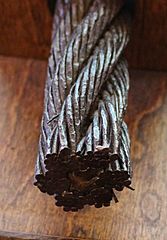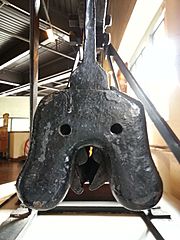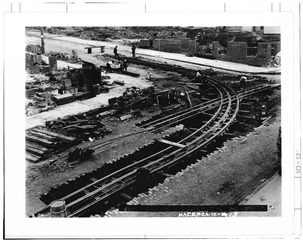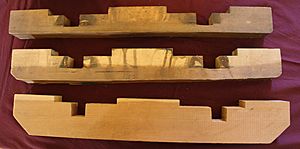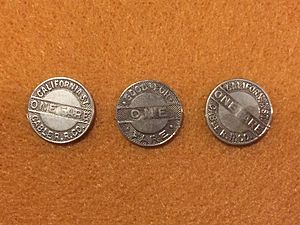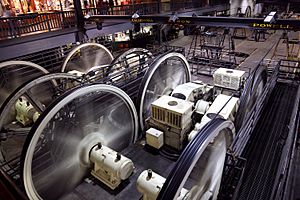San Francisco cable car system facts for kids
Quick facts for kids San Francisco cable car system |
|||
|---|---|---|---|
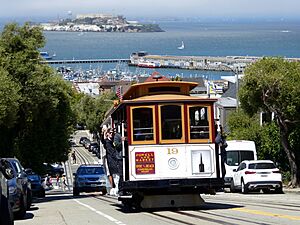
Cable car on Hyde Street in 2023, with Alcatraz Island and Fisherman's Wharf in the background
|
|||
| Info | |||
| Owner | San Francisco Municipal Transportation Agency | ||
| Locale | San Francisco | ||
| Transit type | Cable car | ||
| Number of lines | 3 | ||
| Number of stations | 62 | ||
| Headquarters | San Francisco Cable Car Museum | ||
| Operation | |||
| Began operation |
|
||
| Operator(s) | San Francisco Municipal Railway | ||
| Number of vehicles |
|
||
| Technical | |||
| System length |
|
||
| Track gauge | 3 ft 6 in (1,067 mm) | ||
| Top speed | 9.5 mph (15.3 km/h) | ||
|
|||
The San Francisco cable car system is the last cable car system in the world that is still operated by hand. It is a famous symbol of the city of San Francisco. These cable cars are part of the city's public transport network, which also includes modern light rail and historic streetcar lines. Out of 23 cable car lines built between 1873 and 1890, only three are still running today. Two lines go from downtown near Union Square to Fisherman's Wharf. The third line runs along California Street.
Even though some people use cable cars to get to work, most of the millions of passengers each year are tourists. Because of this, you might have to wait two hours or more to get on. The cable cars are one of San Francisco's most popular attractions. Other famous sights include Alcatraz Island, the Golden Gate Bridge, and Fisherman's Wharf.
San Francisco's cable cars are listed on the National Register of Historic Places. They are also one of only two street railways to be named a National Historic Landmark. The other is the St. Charles Streetcar Line in New Orleans.
Contents
History of San Francisco Cable Cars
How Cable Cars Started
In 1869, Andrew Smith Hallidie had an idea for a cable car system in San Francisco. He reportedly saw a terrible accident where horses pulling a streetcar slipped on wet cobblestones and died. Hallidie got money to support his idea in 1871 and 1872. His main supporters were Henry L. Davis, Joseph Britton, and James Moffit.
The first successful cable-powered train was the Clay Street Hill Railroad. It made its first trip on August 2, 1873. Hallidie promoted the line, and William Eppelsheimer was the engineer. Both got patents for their work on the Clay Street line. This line used "grip cars" that held onto the cable and pulled other cars. The person who operated the grip was called the "grip."
Regular service began on September 1, 1873. The line was very successful and became a model for other cable car systems. Hallidie became rich because other cable car companies had to pay him to use his ideas.
Cable Car System Grows
The next cable car line to open was the Sutter Street Railway in January 1877. This line used a "side grip" and a lever to operate, designed by Henry Casebolt. This new grip allowed cable cars to cross at intersections.
In 1878, Leland Stanford opened his California Street Cable Railroad (Cal Cable). Its first line on California Street is the oldest cable car line still running today. In 1880, the Geary Street, Park & Ocean Railway started. Two years later, the Presidio and Ferries Railway became the first cable company to have curves on its routes. Cars would let go of the cable and roll around these curves.
In 1883, the Market Street Cable Railway opened its first line. This company became San Francisco's largest cable car operator. At its busiest, it ran five lines, all ending at the Ferry Building. During busy times, cars left every 15 seconds.
In 1888, the Ferries and Cliff House Railway opened two lines. The Powell–Mason line still runs on the same path today. Their other line, the Powell–Washington–Jackson line, is now part of the Powell–Hyde line. This company also built the car barn and powerhouse at Washington and Mason. This site is still used today.
In 1889, the Omnibus Railroad and Cable Company was the last new cable car operator in San Francisco. The next year, the California Street Cable Railroad opened two more lines. These were the last completely new cable car lines built in the city. One of them, the O'Farrell–Jones–Hyde line, has a part (Hyde Street) that is still used by the Powell–Hyde line.
In total, 23 cable car lines were built between 1873 and 1890.
| Name | Lines | Gauge | Grip | Start | End | Notes |
|---|---|---|---|---|---|---|
| Clay Street Hill Railroad | 1 | 3 ft 6 in (1,067 mm) | bottom | Sep 1873 | Sep 1888 | Original route along Clay from Kearny to Leavenworth; extended west to Van Ness in 1877. Sold to Ferries & Cliff House Railway; route incorporated into Clay-Sacramento line. |
| Sutter Street Railway | 2 | 5 ft (1,524 mm) | side | Jan 1877 | Mar 1902 | Initial route along Sutter from Market to Larkin, later extended to Central (Presidio); second (crosstown) line added in 1878 along Larkin from Bush to Hayes. Crosstown line eventually extended south along 9th to Brannan and north to Pacific, then west to Fillmore. Consolidated into United Railroads of San Francisco. |
| California Street Cable Railroad | 3 | 3 ft 6 in (1,067 mm) | bottom | Apr 1878 | Jul 1951 | Initial route along California from Kearny to Fillmore; eventually extended west to Presidio and east to Market. Second line added in 1891 (O'Farrell, Jones & Hyde) with small feeder line from Market, Jones & McAllister. Purchased by San Francisco in 1951. |
| Geary Street, Park & Ocean Railway | 1 | 5 ft (1,524 mm) | bottom | Feb 16, 1880 | May 5, 1912 | Initial line ran along Geary from Market to Presidio, where a steam engine was added for service to western terminus at 5th and Fulton. Converted to standard gauge and side grip in 1892 and cable drawn line extended to 1st; franchise expired in 1912 and the line was taken over for Muni. |
| Presidio & Ferries Railway | 1 | 5 ft (1,524 mm) | bottom | Jan 1882 | Apr 1906 | Ran along Columbus from Montgomery to Union, then west along Steiner; continued to Presidio via steam drawn line. Converted to electric following April 1906 earthquake; sold to San Francisco in Dec 1913 and became part of Muni. |
| Market Street Cable Railway | 5 | 4 ft 8 1⁄2 in (1,435 mm) | side | Aug 1883 | Oct 1893 | Main line originated from Ferry Building and ran along Market. Branch lines opened along Valencia south to 29th (1883); and three branches west to Golden Gate Park along McAllister, Haight, and Hayes (1886). Market line extended to Castro, then south to 26th in 1887. Reorganized in 1893 as Market Street Railway and most lines converted to electric. |
| Ferries & Cliff House Railway | 4 | 3 ft 6 in (1,067 mm) | bottom | Mar 1888 | Powell line ran from Powell and Market past Union Square to Bay & Taylor; second line ran along Washington and Jackson to Central & Sacramento, then continued using steam power to Cliff House. Reorganized in 1893 as Market Street Railway. | |
| Omnibus Railroad & Cable Company | 5 | 3 ft 6 in (1,067 mm) | bottom | Aug 1889 | Reorganized in 1893 as Market Street Railway. |
Powering the Cable Cars
At first, steam engines powered the cables. The Ferries & Cliff House Railway built a three-story building for two large coal-burning steam engines. They had a tall smokestack to let out the smoke. By 1890, they added two more powerful steam engines. In 1893, they used about 10 tons of coal every day. In 1901, the system switched from coal to oil, which made less smoke. The smokestack was then made shorter. This shorter smokestack is still at the Washington-Mason car barn today.
In 1912, electricity was introduced. A 600-horsepower electric motor started working. By 1926, all steam power was replaced by electric motors. As fewer cable car lines ran, one 750-horsepower electric motor could power all of them. However, if one cable car broke down, all lines had to stop. So, during a big rebuild in 1984, each of the four cables got its own 510-horsepower electric motor.
Why Cable Cars Became Fewer
The first electric streetcars in San Francisco started in 1892. By 1906, many cable cars were owned by the United Railroads of San Francisco (URR). URR wanted to change many cable lines to electric ones. But people didn't like the idea of ugly overhead wires in the city center.
These concerns disappeared after the 1906 San Francisco earthquake. The earthquake and fires destroyed the power houses and car barns. Many cable cars were also destroyed. This allowed URR to replace most of its cable car lines with electric streetcar lines. By 1912, only eight cable car lines were left. These were on very steep hills where electric streetcars couldn't go. In the 1920s and 1930s, better motor buses also competed with cable cars. By 1944, only five cable car lines remained. Two were the Powell Street lines, owned by the city. Three were owned by the independent Cal Cable company.
Saving the Cable Cars
In 1947, Mayor Roger Lapham wanted to close the two city-owned lines. In response, a group of 27 women's civic groups, led by Friedel Klussmann, formed the Citizens' Committee to Save the Cable Cars. They fought hard and made the city hold a vote. The vote was about changing the city's rules to keep the Powell Street lines running. People voted overwhelmingly to save them. Klussman led another effort in 1948 to have the city buy Cal Cable. This vote didn't pass, but a second vote in 1949 did. The city then started talks to buy Cal Cable.
In August 1951, the three Cal Cable lines closed because the company couldn't afford insurance. The city bought and reopened the lines in January 1952. But another vote in 1953 to fund repairs for the California Street tracks failed. The city's rules didn't protect the new Cal Cable lines. So, the city planned to replace them with buses. Businesses also wanted to change O'Farrell Street for cars, which would remove a cable car line.
The result was a compromise that created the system we have today. It kept the California Street line from Cal Cable. It also kept the Powell–Mason line, which the city already owned. A third new line was made by combining parts of Cal Cable's O'Farrell-Jones-Hyde line with a shorter Powell–Washington–Jackson line. This new line is now called the Powell–Hyde line.
This new plan required some rebuilding. The Hyde Street tracks had to be changed for the single-ended Powell line cars. The whole system also needed to run from one car barn and power house. Even with these changes, much of the system's old parts remained from the time of the earthquake.
Major Rebuilding Project
By 1979, the cable car system was not safe. It had to close for seven months for urgent repairs. Engineers then said it needed a complete rebuild. This would cost $60 million. Mayor Dianne Feinstein helped get money from the government for most of the rebuild. In 1982, the cable car system closed for this big project. Workers replaced tracks and cable channels in 69 city blocks. They rebuilt the car barn and power house. New equipment was installed, and 37 cable cars were repaired or rebuilt. The system reopened on June 21, 1984. This was just in time for the 1984 Democratic National Convention, which brought a lot of attention to San Francisco.
Recent Cable Car Updates
Since 1984, Muni (the city's transit agency) has kept improving the system. They have rebuilt old cars and built new ones. They also built a new terminal and turntable at the Hyde and Beach end of the line. Another new turntable was built at the Powell and Market end.
Between 2017 and 2019, the system had another, smaller rebuild. Workers fixed the cable car system's gearboxes, which had been in use since the 1984 rebuild.
The system closed in March 2020 because of the COVID-19 pandemic. Cable cars don't have a separate area for operators, unlike buses. Limited service on all three lines started again on August 2, 2021. Full service began on September 4. On September 9, a problem caused the fire system in the carbarn to turn on, cutting off power. Service started again on September 18.
How San Francisco Cable Cars Work
Cables and Grip
Cable cars are pulled by a strong cable running under the street. A part called a grip extends from the car through a slot in the street. This grip holds onto the cable. Each cable is about 1.25 inches (3.2 cm) thick. It moves at a steady speed of 9.5 miles per hour (15.3 km/h). A 510-horsepower electric motor in the central power house drives the cable.
Each cable has six steel strands, with 19 wires in each strand. They are wrapped around a sisal rope core, which helps the grip hold on better. The cable is covered with a special lubricant to reduce wear. In the past, pine tar was used. To start and stop the car, the grip operator closes and opens the grip around the cable. This is like using a clutch in a car. The grip's jaws press on the cable with a lot of force. Because of wear, the grip's parts need to be replaced every three days.
There are four separate cables. One is 16,000 feet (4,900 m) long for the Hyde section, and another is 10,300 feet (3,100 m) long for the Mason section. A 9,300-foot (2,800 m) cable is for their shared Powell section. The California Street line has its own 21,000-foot (6,400 m) long cable.
Braking Systems
Besides the cable itself, which slows cars down when going downhill, cable cars have three different ways to brake:
- Wheel Brakes: Metal brake shoes press on the wheels. On the Powell lines, the grip operator uses a foot pedal for the front wheels. The conductor uses a handle for the rear wheels. On the California Street line, there are pedals near both grips.
- Track Brakes: Wooden brake blocks press against the track when the gripman pulls a lever. These four blocks are made of Monterey Fir wood. They can smell like burning wood when used. They need to be replaced after only a few days.
- Emergency Brake: This is a piece of steel, about 1.5 inches (3.8 cm) thick and 18 inches (46 cm) long. It hangs under the car. When the gripman pulls a red lever, it pushes into the track slot. It gets stuck tightly and often needs a special cutting torch to be removed.
Electrical Power
Over the years, cable cars have gotten some electrical parts. These include headlights, inside lights, a GPS tracking system, and cameras. But unlike most modern trains, cable cars don't make their own power. They use large batteries that are charged at the car barn. In 2018, the old light bulbs were replaced with LED bulbs. These new lights help operators see better and use less battery power.
Cable Car Routes
The cable car system today has three routes:
- Powell–Mason Line (Line 59 or PM): This line shares a path with the Powell–Hyde line. It goes north and steeply uphill from Powell and Market Streets. It crosses the California Street line at the top of the hill. Then, cars roll downhill without the cable for three and a half blocks. The lines then split. This line turns north and goes downhill along Mason Street. It briefly goes along Columbus Avenue, then down Taylor Street. It ends at Taylor and Bay, two blocks from Fisherman's Wharf and closest to Pier 39. Like the Powell–Hyde line, there are hand-powered turntables at each end to turn the cars around. The Powell–Mason line has been running since 1888.
- Powell–Hyde Line (Line 60 or PH): This line also starts at Powell and Market Streets and goes steeply uphill. It crosses the California Street line at the top. Cars then roll downhill without the cable for three and a half blocks. This line continues uphill on Jackson/Washington to Hyde Street. Here, the line turns north past the "crooked" Lombard Street. It then goes steeply downhill (at 21%, the steepest hill in the system) along Hyde Street. It ends at the Hyde and Beach terminal, near the San Francisco Maritime Museum and Ghirardelli Square. Like the Powell–Mason line, it has hand-powered turntables at each end. This line was created in 1957 from parts of older lines. It is the most popular with tourists because it offers great views of Alcatraz Island and passes Lombard Street. This means long waits to board.
- California Street Line (Line 61 or C): This line runs east and west on California Street. It goes from California and Market Streets, near the Embarcadero, to Van Ness Avenue. California Street cable cars use "double-ended" cars. These cars have grip levers at both ends. They can be driven in either direction without being turned around. The line used to be much longer, but service west of Van Ness Avenue stopped in 1954. People sometimes ask to bring back the full route, but no serious plans have been made. This route goes uphill to the top of Nob Hill, then gently downhill to Van Ness Avenue. This line is used more by people commuting to work, especially on weekdays.
There are also tracks that connect the California Street line to the Powell–Hyde line on Hyde Street. This connection lets California Street cars get to the car barn.
A small signal tower controls where the lines cross at California Street and Powell Street. It has been rebuilt several times, most recently in 2020–2021.
Fares to Ride
As of January 1, 2020, a single ride on a cable car costs $8. However, seniors riding before 7 am or after 9 pm pay $4. Cable car rides are included in monthly Muni passes and 1-day, 3-day, and 7-day passes. They are also part of the CityPASS program. Passes on a Clipper card can be read by the conductor using a mobile device. You cannot use transfers or old fare receipts. In the 1960s, a single ride cost only 15 cents.
Cable Car Vehicles
There are 27 cable cars used when the system is running. They come in two main types:
- Single-ended cars are used on the Powell–Hyde and Powell–Mason lines. These cars have an open front section with seats facing out. The gripman sits here with many levers for the grip and brakes. The back half of the car is enclosed with seats facing inward. There are entrances at each end and a small platform at the back. These cars are about 27 feet 6 inches (8.38 m) long and 8 feet (2.4 m) wide. They weigh about 15,500 pounds (7,000 kg). They can carry 60 passengers, with 29 seated. These cars must be turned around at the end of the line using turntables. Most of these cars were built or rebuilt by Muni's Woods Carpentry Division.
- Double-ended cars are used on the California Street line. These cars are a bit longer. They have open grip sections at both ends and an enclosed section in the middle. They are about 30 feet 3 inches (9.22 m) long and 8 feet (2.4 m) wide. They weigh about 16,800 pounds (7,600 kg). They can hold 68 passengers, with 34 seated. The California Street line does not have turntables. So, these cars must be able to go in both directions. Some of these cars are old O'Farrell, Jones, and Hyde Street cable cars. Others were built by Muni's Woods Carpentry Division.
There are 28 single-ended cars for the Powell lines and 12 double-ended cars for the California Street line.
Both types of cars ride on two sets of four-wheel trucks. These fit the track's 3 feet 6 inches (1,067 mm) narrow gauge. The term California Street car means a car running on that specific line. It's different from the term California Car. The latter term refers to the style of all cable cars in San Francisco today. It shows they are different from older styles where the open grip section and enclosed section were separate cars.
Sometimes, old cable cars are replaced with new or restored ones. The old cars are stored for future restoration. There are two historic cable cars, numbers 19 and 42, stored in the cable car museum. They were used on the Sacramento-Clay and O'Farrell, Jones and Hyde Street lines.
Car Barn, Power House, and Museum
The cable-car barn is between Washington and Jackson Streets, uphill from where Mason Street crosses them. Cars back into the barn from Jackson Street and drive out onto Washington Street. To make sure single-ended cars face the right way, the car barn has a fourth turntable. A rubber-tired tractor helps move cars around the barn.
As of 2018, the car barn had 17 mechanics, six custodians, three carpenters, two painters, two supervisors, and one superintendent.
The car barn is right next to the power house and the Cable Car Museum. The museum's entrance is at Washington and Mason. It has several old cable cars, smaller exhibits, and a gift shop. Visitors can look down into the main power house from two viewing areas. They can also go below the street at Washington and Mason. There, they can see the large space where the cables are guided out to the street by huge sheaves (wheels).
Cable Car Crew
The grip drives the car. This job needs strength, coordination, and good balance. The grip must smoothly grab and release the cable. They also need to know where to let go of the cable to roll over other lines or places where the cable doesn't follow the tracks. They must also keep the car clear of other traffic. The conductor collects fares, manages how crowded the car is, and controls the rear-wheel brakes on some hills.
Every July, usually on the second or third Thursday, there's a cable car bell-ringing contest in Union Square. Cable car crews compete after a first round in June. Judges give points to decide who goes to the finals.
Images for kids
See also
 In Spanish: Funicular de San Francisco para niños
In Spanish: Funicular de San Francisco para niños
- 49-Mile Scenic Drive
- List of heritage railroads in the United States
- San Francisco Railway Museum
- St. Charles Streetcar Line, a streetcar line in New Orleans with National Historic Landmark status
- Great Orme Tramway, a similar cable-hauled street-running railway


